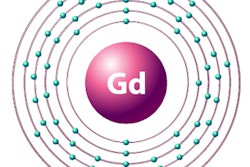
The controversy over retained gadolinium from MRI just got personal. The lawsuit filed November 1 by action film star Chuck Norris and his wife Gena against 11 firms linked to the manufacture and distribution of gadolinium MRI contrast puts a public face on the issue and could influence the debate over how these agents should be regulated.
Until the Norrises' lawsuit was filed on November 1, discussion about gadolinium retention was mostly taking place in the pages of academic journals or in the halls of regulatory agencies such as the U.S. Food and Drug Administration (FDA). Now, gadolinium manufacturers face a well-financed, publicly recognizable opponent who won't pull punches -- particularly when it comes to questions about how gadolinium safety has been handled in the U.S. by the FDA and contrast manufacturers.
"I don't want to condemn the whole system, but if you do an analysis of the history you will see the FDA is less proactive than European regulators," said Todd Walburg, an attorney for Cutter Law, the Oakland, CA, firm representing the Norrises. "There is huge money at stake in this industry. The companies want to protect the products, and I'm sure radiologists want to protect the products because it is their livelihood."
Gena's story
Gena and Chuck Norris married in 1998 and have led an active life that includes raising twins and running a variety of companies and charitable foundations -- to say nothing of managing Chuck's career, which includes television shows such as "Walker, Texas Ranger" and movies such as "The Expendables" and "Missing in Action."
 Chuck and Gena Norris. Image courtesy of Cutter Law.
Chuck and Gena Norris. Image courtesy of Cutter Law.In 2013, Gena began experiencing symptoms of rheumatoid arthritis, so she underwent a series of three MRI scans over eight to 10 days to investigate the condition. The scans all involved the administration of gadolinium-based MRI contrast, specifically ProHance and MultiHance (Bracco Diagnostics).
Not long after the third scan, Gena began experiencing "terrible burning sensations" throughout her body, according to Walburg. She was hospitalized in the emergency room (ER) in Texas multiple times, with Chuck driving her to the ER in the middle of the night, Walburg said.
Gena's doctors assured her that the gadolinium contrast she received wasn't causing her symptoms because she had normal kidney function at the time of the scans. While gadolinium contrast has been implicated in the development of nephrogenic systemic fibrosis (NSF), a debilitating skin and tissue disease, NSF occurs in patients with compromised renal function. The development of NSF largely disappeared after FDA warnings and clinical guidelines barred the use of gadolinium contrast in patients with damaged kidneys.
Without any answers from Gena's doctors, the Norrises embarked on an "odyssey of medical treatment" to find out what was causing her ailments, often pursuing experimental treatments, Walburg said. For example, they flew Gena to Reno, NV, in a plane outfitted with a hospital bed and a paramedic on board to undergo a series of chelation treatments designed to gather free gadolinium in the body so it can be expelled through the urine, according to Walburg. Chelation therapy is not approved by the FDA, and so it has to be performed off-label by doctors and is very expensive, he said.
The Norrises also traveled to China to undergo stem cell therapy, in which stem cells from umbilical cords were injected into Gena's spine. Gena finally began to feel better after spending a month in China receiving stem cell and chelation therapy; she continues to undergo stem cell therapy -- at $5,000 a shot every three months -- now that she's returned to the U.S.
"She has found out that is the best treatment, but no one else can afford that treatment," Walburg told AuntMinnie.com. "They are lucky to have the resources to be able to do all this."
A break in the case
The Norrises continued to be baffled by Gena's condition until the publication of a paper in May 2016 in the American Journal of Roentgenology. In the paper, researchers led by Dr. Richard Semelka of the University of North Carolina at Chapel Hill urged that a new nomenclature be developed to describe patients who were experiencing aftereffects of gadolinium but whose symptoms fell short of NSF -- they proposed "gadolinium deposition disease," or GDD.
The Semelka paper was an aha moment for the Norrises, as well as for other individuals who believe they have symptoms from gadolinium contrast, and they soon began banding together to support each other.
 Todd Walburg of Cutter Law. Image courtesy of Cutter Law.
Todd Walburg of Cutter Law. Image courtesy of Cutter Law."When that literature came out, patients started to form victim support groups online," Walburg said. "People started realizing that they had similar complaints, and they have all been supporting each other through this."
The term "gadolinium deposition disease" figures prominently in the complaint that Walburg's firm filed November 1 in the Superior Court for the State of California in San Francisco. The complaint defines the condition as a "disease process observed in people with normal or near-normal renal function who develop persistent symptoms that arise hours to months after the administration of gadolinium-based contrast agents." Individuals with gadolinium deposition disease have symptoms that are consistent with the known toxic effects of gadolinium, the complaint states, such as persistent headaches, bone and joint pain, and clouded mental activity.
The complaint goes on to note the differences in chemical composition between the two main types of gadolinium agents: linear and macrocyclic compounds. The document describes macrocyclic agents as having a gadolinium ion that's more completely encased in a protective layer (called a chelate) than linear agents, resulting in a stronger chemical structure that's less likely to release free gadolinium into the body (this claim mostly parallels what's been published in the clinical literature).
Potential problems with the stability of linear agents were noted as early as 1986, according to the complaint, when an article published in Magnetic Resonance in Medicine warned about the release of gadolinium from linear agents and recommended the use of macrocyclic products. Other research since then has documented stability issues with linear gadolinium contrast, the complaint claims.
The publication of research in 2013 by Kanda et al documenting residual gadolinium in patients years after they received MRI contrast scans drew new attention to the safety of gadolinium contrast and prompted the FDA to begin reviewing the safety of the products. But the agency so far has declined to pull linear contrast agents off the market, unlike European regulators, which have recommended that sales of three linear agents be discontinued.
In their complaint, the Norrises charge that the defendants in the case have known about the health risks of ProHance and MultiHance, but they "have continuously failed to warn consumers and their healthcare providers on the labels of their products." A labeling change in 2012 designed to warn of contraindications for patients with impaired kidney function did not "reflect the extensive evidence of gadolinium retention in people with normal renal function."
The complaint seeks compensation for the estimated $2 million that the Norrises have spent on out-of-pocket medical expenses, as well as monetary damages from contrast makers and distributors in excess of $10 million. The Norris lawsuit is one of 16 cases that Cutter Law has filed on behalf of individuals with gadolinium deposition disease, all of which involve linear agents, Walburg said.
The lawsuit names Bracco and several affiliated companies, as well as firms involved in the distribution of MRI contrast, such as McKesson, Takeda, Acist Medical Systems, and Merry X-Ray Chemical.
McKesson issued a statement on November 1 saying that it is reviewing the complaint. For its part, Bracco said its corporate policy is not to comment on litigation, but the company noted that GBCAs have been part of standard clinical practice for 30 years, and the company is committed to working with the FDA and other regulatory authorities to mitigate any potential risk to patients.
A failure of the system?
Gena Norris continues to recover. While her condition has improved compared with the months after her initial MRI scans, she tires easily and has had to cut back on her busy schedule and her involvement in the family's operations. For example, she often had to take a break when doing interviews with media about the lawsuit, Walburg said.
The Norrises have been active in the gadolinium patient community for the past year, going public with her condition in June 2017 and submitting a prepared statement at an FDA hearing on gadolinium in September. Chuck has also penned several articles detailing their fight. But the Norrises decided to pursue litigation as a way to further publicize their situation and those of others who may have gadolinium deposition disease.
"One of their main motivations is to try to get the word out about this condition and the risk of gadolinium, because the risks have been hidden so far," Walburg said. "Doctors are told by the pharmaceutical companies that there is no real risk if patients don't have reduced renal function. The Norrises want other patients to know about the risks of MRI with contrast. They want people who may have been subjected to gadolinium already to know that there is a name for their condition and it's not just all in their head."



















